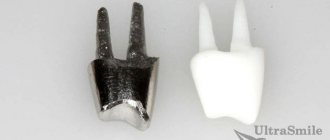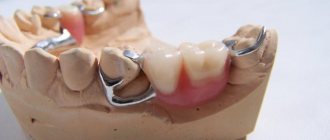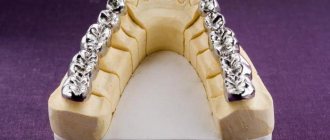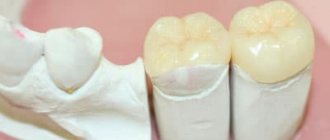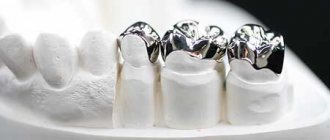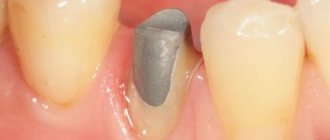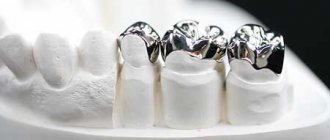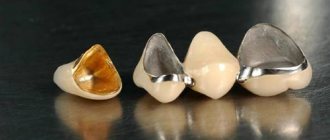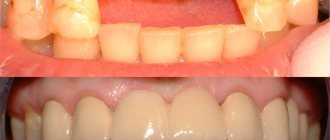What is a core inlay for a crown?
A stump inlay is an orthopedic structure that serves as a support for installing an artificial crown on a severely damaged tooth. This prosthetic element is also called a pin stump inlay, since its root part resembles a dental pin. It is inserted into the dental root canal, and a crown is placed directly on the coronal tip of the inlay, similar to the stump of the prepared tooth. The post-stump inlay should not be confused with a regular dental inlay, which is used as an alternative to fillings.
Advantages of using stump tabs
- The core inlay is made according to individual impressions of the patient and completely reproduces the space of the canals of the tooth to be restored with a crown.
- The stump inlay also has an upper part - in the shape of a tooth ground for a crown. This structure of the microprosthesis ensures uniform load distribution even under strong pressure while chewing food.
- The core tab may have several pins to restore a multi-rooted tooth.
What are the advantages and disadvantages?
This method can restore a seemingly completely hopeless tooth. If the root system has been preserved and is in satisfactory condition, there is every chance that the crown on an artificial stump will last for many years. The advantages of this prosthetic technique include the following:
- strength and reliability of fixation of the entire prosthetic structure even with severe tooth decay,
- uniform distribution of chewing load,
- high wear resistance even under conditions of intense chewing loads,
- the ability to achieve good aesthetics when using zirconium models,
- significant extension of the service life of a damaged tooth - such inlays do not overload the root, which means they are hundreds of times better than pins that apply pressure only in one plane,
- affordable cost compared to implantation.
REPROSTHETICS WITH ACRYLIC PROSTHETICS - RUB 200,000.
Re-prosthetics with an acrylic bridge on a metal frame (all included) up to 12 units.
Save RUR 30,000. Call now or request a call
If the crown is damaged, it can always be replaced with a new one without the need to remove the tab itself (of course, if the situation allows it). As for how long such a design will last, much depends on the quality of the installation itself and hygiene on the part of the patient. The average service life is about 5 years, and modern alloys and zirconium dioxide can last for many years with proper care.
If we talk about the disadvantages, then in this regard we can only highlight the relatively high cost if we compare this technique with restoration on a pin. This may also include the duration of treatment, because the patient will have to visit the dentist several times. On the other hand, in the case of the same implantation, preparation and treatment itself require much more time, and you lose the tooth.
Types of materials for stump inlays
According to their structure, stump inlays in dentistry are divided into cast stump inlays and collapsible stump inlays. Non-separable stump inlays consist of a stump part and 1 - 2 pins, therefore they are used for prosthetics of teeth that have no more than two channels. Collapsible stump pin inlays differ from cast stump pin inlays in that they are used for teeth that have 3-4 canals, and are equipped with a corresponding number of root pins, which are specially made removable, since otherwise it will be impossible to insert them into the root canals. Depending on the materials of the stump inlays, the following types of these microprostheses are distinguished, described in the table below.
| Metal stump inlay | The metal stump inlay can be made of an alloy of chromium and cobalt; there are also silver stump inlays and gold stump inlays. They are reliable, but not aesthetic, therefore, in modern dentistry, gold core inlays and silver microprostheses are used quite rarely and only for prosthetics of chewing teeth. |
| Metal-ceramic core inlay | A core inlay made of metal-ceramics is quite strong, but its quality is worse than that of inlays made from other materials due to the difference in thermal expansion of metal and ceramics. Therefore, such microprostheses often fall out. |
| Ceramic core inlay | A ceramic core inlay best preserves the aesthetics of a smile, since ceramics in its properties and appearance are as close as possible to natural tooth enamel. In this regard, the stump inlay for the front tooth is made from this material. |
| Zirconium core inlay | The advantage of such structures is not only their high strength, but also the white color of the stump inlay made of zirconium dioxide, which does not show through the crown. Therefore, as an answer to the question “Which stump inlays are better?” Along with a ceramic inlay, we can safely call a pin-stump inlay made of zirconium oxide or dioxide. Thus, the stump inlay for the front tooth can also be made from zirconium. |
| Composite stump inlay | A type of core inlay with a pin that adheres to the tooth tissue better than others, but is not strong enough compared to inlays made from other materials. |
When is this method contraindicated?
Prosthetics with this method are not performed in dentistry if the nerve is still alive. For such cases, traditional filling is recommended, which will help hide the aesthetic defect. Among other contraindications, experts identify the following conditions:
- the root is severely damaged and does not adhere well to the periodontium,
- the channels are not treated, inflammatory and purulent processes continue in them,
- the teeth are too loose, and it is no longer possible to fix them in one position, which means it is useless to install inlays,
- There is a pronounced recession of gingival and bone tissue around the affected element.
Don't know what type of prosthetics to choose?
We will help in the selection, advise where to read more information and compare types of prosthetics.
Consultation with an orthopedic doctor in Moscow clinics is free! Call now or request a call
Working hours: from 9:00 to 21:00 - seven days a week
You need to understand that the pin structure goes deep enough into the root. If the patient is intolerant to metals, an allergic reaction may occur. Therefore, it is better to take an allergy test in advance or choose an option made from a different material.
Making a core inlay for a crown
For the manufacture of stump pin inlays, direct and indirect methods are used. The direct method of manufacturing a stump insert has the following steps.
- After preliminary treatment of the tooth canals and its preparation for the stump inlay, the cavity is treated with Vaseline.
- The plastic, heated to a viscous state, is poured into a syringe and squeezed into the cavity through a wide needle to form an inlay.
- The pin is processed with the same material and inserted into the canal.
- After the plastic structure has hardened, the finished model of the inlay is removed from the cavity and sent to a dental laboratory for the manufacture of a microprosthesis from the material chosen by the patient.
The indirect method includes the following stages of manufacturing a stump inlay:
- After preliminary preparation of the tooth and canals, the doctor takes an impression and transfers it to the dental laboratory.
- The technician casts a plaster model and creates a prototype of the inlay from wax.
- Based on the wax sample, a metal stump inlay is made.
If we talk about stump inlays made of zirconium or ceramics, then CAD/CAM technologies are used for their production, which involve computer modeling of a microprosthesis, transferring the model to a milling machine and subsequent “cutting out” of the inlay from the workpiece.
Installation of the stump tab
Before prosthetics with stump inlays, it is necessary to remove the nerve and carry out endodontic treatment of the canals in order to eliminate their inflammation and seal them properly. After this, the tooth is prepared for an inlay, the canals are unfilled to 1/3 or 2/3 of their length, they are made wider and given a conical shape, and then procedures typical for the direct or indirect method of manufacturing a microprosthesis are carried out.
Stages of installing the stump tab
- All teeth are disinfected with alcohol and dried.
- The stump tab is degreased and covered with cement along with the pins.
- The holes in the channels are filled with a solution, and a microprosthesis is installed in them.
- For final fixation of the stump tab, the doctor applies strong pressure on it.
After this, all that remains is to take impressions from the stump insert installed in the tooth to make a crown from the material chosen by the patient.
Care after prosthetics
Caring for your teeth after installing a core prosthesis differs little from normal oral hygiene. This should include brushing your teeth twice daily. In this case, it is better to use a brush with soft bristles.
After each eating session, it is advisable to rinse your mouth with warm water, herbal infusions (chamomile, sage) or special ready-made mouth rinses.
To clean the interdental spaces, use floss or a brush.
It is advisable to visit a dentist every six months.
What is the difference between a pin and a stump inlay?
The fundamental difference between a pin and a stump inlay is that it is placed under a filling. Previously, a similar technique was used to treat severely damaged teeth when it was not possible to install a crown. Subsequently, this method discredited itself with a large number of complications in the form of secondary caries. Moreover, detecting a carious process under an extensive filling on a pin was quite problematic. Often, such treatment led to severe damage to the tooth by caries and, as a consequence, to its removal.
Let's compare the disadvantages and advantages of the pin stump insert and the pin presented below:
Pros and cons of the stump Pros and cons of the pin
tabs
- a tight fit protects the tooth from pathogenic bacteria and the development of secondary caries;
- withstands significant chewing loads;
- has a long service life;
- does not require replacement in case of wear of the artificial crown.
- established in two visits to the doctor;
- involves significant grinding of living tooth tissue;
- costs more than a regular pin.
- costs less than stump inlays;
- installed in one visit;
- involves a smaller volume of preparation of living tooth tissue;
- unable to withstand the usual chewing load, over time the seal on the pin begins to collapse;
- the pin can be installed in only one dental canal;
- a loose fit allows bacteria access into the dental cavity, which provokes the appearance of secondary caries;
- lasts no more than 2-3 years.
Answering the question “Which is better - a stump inlay or a fiberglass pin,” most experts are inclined to favor dental inlays. Considering the unreliability of installing a filling on a pin, such a service can be found extremely rarely in modern dentistry. The most correct option would be to use a stump tab and then install a crown on it. The choice is due to the fact that this microprosthesis not only strengthens the crown, but also protects the tooth from further destruction throughout life.
Preparation
It is important to provide conditions under which the microprosthesis will be installed tightly, but without squeezing healthy tissue. When forming a cavity, it is taken into account that the restored tooth must withstand chewing loads. In the presence of carious processes, all damaged tissue is removed before formation.
Fissure and spherical burs are used for opening. If tooth decay occurs from the tongue, access should be provided from the chewing surface. The enamel, under which the dentin is destroyed, should be removed, since it will break under the slightest load.
When chewing food, the tooth is exposed to multidirectional loads from different sides. To redistribute pressure forces, the walls must be made at right angles. An additional cavity of a special shape (“dovetail”, letter T) will help neutralize horizontal forces.
To avoid exposing the pulp when preparing a tooth, it is important to work especially carefully with instruments in places where the pulp is located as close to the surface as possible. In older patients, the pulp zone is safer and thicker due to sclerosis. To prevent secondary caries, the defect should be prophylactically widened and a bevel should be provided at an angle of 45 degrees (if the material for the inlay is not a composite, a bevel is not made for it so that the structure does not become fragile).
How much does it cost to fix a stump tab?
The price of a stump inlay in Moscow depends on the material of manufacture, its size, type and number of pins. A single-root stump inlay made of chromium and cobalt alloy will cost from 2,000 rubles. And when a tooth has several roots, the cost of a cast stump inlay for a metal tooth can increase to 5,000 rubles. The price of a stump pin insert made of composite is approximately 6,000 rubles, and of ceramics - about 12,000 rubles. The cost of zirconium core inlays starts from 15,000 rubles. If we are talking about a collapsible design, then the price of a stump inlay for a crown will be slightly higher than that of a solid-cast stump inlay.
